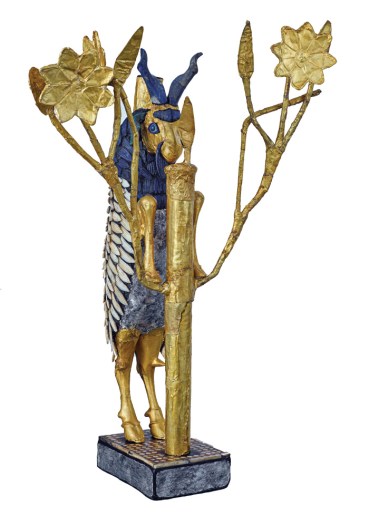What is it?
This ancient Mesopotamian sculpture known as the ‘ram in the thicket’ is actually a ‘goat in a tree’. The goat is rendered in impressive detail, as it reaches up to eat leaves on high branches – a common sight along the banks of the Tigris and Euphrates rivers.

The sculpture was made of wood with hammered sheet gold used to embellish its surface. The goat was then covered in an intricately carved shell and lapis lazuli to form its fleece, and the expressive face was highlighted with lapis eyes, beard, and horns. The result is a spectacular display of the sculpting, lapidary, and goldsmithing arts. Measuring 42.5cm in height and with a supporting pole emerging from the goat’s back, it was probably meant to be a decorative stand that held a small bowl for offerings or incense.
Where was it found, and when?
The sculpted furnishing was found with a similar second one (now in the British Museum) during the 1928-1929 season of Leonard Woolley’s excavations of the ancient city of Ur in modern Iraq. Both lay in the west corner of the ‘Great Death Pit’, a c.2450 BC grave containing the remains of 74 people, most of them bejewelled women. One woman (Body 61) found near the goat sculptures was more highly adorned than the others and may have been the primary burial, for whom all the rest were sent to the afterlife in a symbolic banquet.
After 4,500 years deep in the soil, the wooden sculpture had decayed and the decorated outer shell had been crushed flat. At first, it was consolidated as found but then, after much conservation, stabilised and displayed in its original glory.
Why does it matter?
Not only does this piece demonstrate the artistic skill of Early Dynastic Mesopotamia’s craftspeople, it also reflects wealth, status, belief, and the importance of trade networks.
Southern Mesopotamia lacked resources such as stone, metal, and building timber. Successful kings and queens organised trade to bring in these much-needed goods. Luxuries, later made into fantastic objects for the royals, also came along these networks. The trade network exemplified by the ‘ram in the thicket’ reached all the way to Afghanistan, more than 2,000km from Ur.
The materials for the splendid goat furnishings were exotic, but the subject was local. It probably represents the fertility of the land. The eight-pointed flowers on the trunk are the sign of Inanna; the goat is the sign of her consort Dumuzi.
These two deities are associated with the changing seasons and the cycle of life and death, making this an appropriate funerary offering. But for whom?
A cylinder seal from the grave suggests that the woman found lying near the goat sculptures, who may have been the primary burial, was a high priestess of the moon god, Nanna. This position, better evidenced in later periods, was held by the daughter of the reigning king. Her name and dynasty, however, remain unknown.
